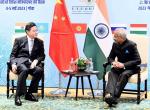Defence and economic cooperation are two prominent and defining aspects of any bilateral relationship in today’s world. While evaluating the growing bilateral relationship between India and Australia, it is heartening to note that in both these areas, the two countries have been moving rapidly over the last few years. Indian investments in Australia was recorded at AUD 10.9 billion in 2014, while Australian investment in India touched AUD 9.8 billion with annual bilateral trade reaching nearly AUD 16 billion (Department of Foreign Affairs and Trade, 2015). Even though in absolute terms these figures are rather modest when viewed in the context of the vast potentials on both sides, the important point of note is the fact that the two countries have shown the right and earnest intent to move forward. The economic and commercial aspects of the bilateral relationship are destined to reach new heights with India emerging as a significant economic partner for Australia. What is equally notable is the fact that given the strategic location of India in the Indo-Pacific region, its long tradition of democratic values and abiding commitment to freedom of navigation and free trade, makes India a key strategic partner of Australia. Both countries seem to have realized that time was now ripe for them to graduate to developing strong bilateral security relationship that can play a crucial role in ensuring peace, security, stability and prosperity of the Indo-Pacific region.
These thoughts were defined by the visiting Australian Minister for Defence, Kevin Andrews during a remarkably frank and forthright expose at the Institute for Defence Studies and Analyses, New Delhi on the topic ‘Australia’s Defence Policy and Relationship with India' where he summed up the synergy of the India-Australia defence relationship and its strategic importance . Kevin Andrew said, “We share history, democratic values, and an interest in the prosperity and security of our region – which underpins that future potential. We will both benefit from a more rules-based global order, which will drive our economic growth. Importantly, we see these opportunities to work more closely in Defence to protect the order and encourage that prosperity for both our nations and the broader region, in the future. We therefore see enormous potential in our bilateral defence relationships, and so look forward to working with India towards achieving these goals” (Andrews, 2015). The growth oriented approach and in the shared pursuits of security interests defines the synergy, rising prospects of stronger India-Australia defence cooperation.
Earlier, in a similar vein, Indian Prime Minister Narendra Modi had also, in his address to Australian Parliament late last year, highlighted the growing importance of Australia-India relations when he said; “Today, the world sees Australia to be at the heart of the Asia Pacific and Indian Ocean region. This dynamic region holds the key to this world's future; and Australia is at its cross-currents. And, as Australia has become more engaged in this part of the world, we welcome its growing role in driving this region's prosperity and shaping its security”. PM Modi underlined greater significant role for Australia in developing India, “Australia will not be at the periphery of our vision, but at the center of our thought. So, we stand together at a moment of enormous opportunity and great responsibility. I see a great future of partnership between India and Australia and, a shared commitment to realize it” (Modi, 2014).
India-Australia bilateral relations has been evolving steadily over the last decade, especially since 2009, when the two countries elevated their relationship to a strategic partnership fostering defence ties with periodic consultations across wide range of issues from security and strategic domain. Despite certain hitches in congruence of interests and ideas pertaining to strategic partnership in the nuclear cooperation especially about the sale of uranium to India with both sides consulting and striving to reach constructive consensus in this regard. The constructive tone and tenor set during PM Modi’s visit to Canberra in November 2014 during which the significance of furthering strong defence relationship was formally recognized at the summit level; thus, resulted into formalization of a framework for security cooperation to facilitate greater defence interaction between the two countries (Ministry of External Affairs, 2014). India also has put in lot of effort to strengthen its influence in this region and is evident from its active contribution through Indian Ocean Rim Association (IORA) and India’s own initiative in the form of Indian Ocean Naval Symposium is widely acclaimed and has newly defined the security architecture of the IOR.
It is in this encouraging backdrop of bonhomie, both countries recently concluded their first ever Bilateral Maritime Exercise – AUSINDEX-15 from September 11 – 19, 2015. The Eastern Fleet of the Indian Navy was the host of this exercise which fits in well with India’s ‘Act East’ policy initiative. India as mentioned above, considers Australia one of the key strategic partners in the newly emerged strategic geography of the Indo-Pacific. The current phase of intense engagement and defence cooperation in furthering strong defence relations is amply reflected in the ongoing AUSINDEX-15.

The focus of the AUSINDEX-15 exercise was on integrated operations with surface, air and sub-surface forces comprising:-
- planning and the conducting anti-submarine warfare exercises;
- helicopter cross deck operations;
- surface and anti-air firing exercises; and
- Seamanship exercises.
AUSINDEX-15 was a multiphase exercise and comprised of harbor phase encompassing briefings and practical demonstrations along with professional interaction, followed by Sea phase engagement which includes Fleet maneuvers, gun firing as well as coordinated anti-submarine exercises and concluded with crucial de-briefing phase. This maritime exercise is considered a start for attaining interoperability between Indian and Australian Navies. The exercise had comprehensive objective projecting the joint interests of both the countries in;
- strengthening relationships and understanding of procedures through professional as well as social interactions;
- enhancing mutual understanding and cooperation through conduct of mission-specific briefings, table top exercises and scenario-based practical demonstrations and exercises;
- exchanging professional views through the conduct of sharing experiences on specific topics of interest; and
- enhancing proficiency in core mariner skills, professional standards, safety and communications (Andrews, 2015).

The exercise was executed off the Visakhapatnam Port in the Bay of Bengal, which is a second largest port of India in terms of cargo trade by volume. It has a natural harbor structure due to its ideal location in the area of creek through which the coastal river Narava Gedda joins the Sea. It has three major harbors; outer harbor, inner harbor and the fishing harbor. The Dolphin’s Nose hill to the North of the entrance of the channel protects the harbor from cyclones that often strikes the East coast. AUSINDEX-15 focused on anti-submarine warfare and featured prominently coordinated anti-submarine military exercise. The Australian Navy participated with its Lockheed Martin’s P-3 anti-submarine reconnaissance aircraft along with Collins-class submarine (HMAS Sheean), a fleet tanker (HMAS Sirius) and Anzac class frigate (HMAS Arunta). The Indian Navy has deployed its assets as stealth frigate (INS Shivalik) , a guided missile destroyer (INS Ranvijay), a Fleet tanker (INS Shakti) and a corvette. In addition, one Royal Australian Air Force P-3C Orion surveillance aircraft and Indian Navy’s P-8I Poseidon Long Range Maritime Reconnaissance and Anti-Submarine Warfare aircraft operated from Chennai air field during the exercise (Indian Navy, 2015).
In this context, question that naturally arises is what brings regional mid-powers like India Australia together? The prominent factor could be the phenomenal rise of China as a military power and its assertive posturing in the IOR. This is causing serious concerns not only to the countries abutting the South China Sea but even to the others like Japan, South Korea and of course the US. India and Australia, with vital interests in the region, cannot remain un-touched by these developments that impinge on their shared common vision about regional as well as global security along with their strong commitment towards the execution of freedom of navigation and space. The Australian view on some of these developments got defined in Australian Defence White Paper-2013 wherein it was stated, “China’s defence capabilities are growing and its military is modernising, as a natural and legitimate outcome of its economic growth. This will inevitably affect the strategic calculations and posture of regional countries and is changing the balance of military power in the western Pacific. With China’s global interests expanding, it is becoming more active on a broader range of international issues (Department of Defence 2013).”
Highlighting the possible flashpoints in the Indo pacific, the paper referred to Australia’s concerns over the Korean peninsula, Taiwan Strait, East and South China Sea as potential threats that could destabilize the regional security order and cautioned about the risk of miscalculations or small incidents leading to escalation. It recommended establishment of effective mechanism to manage these pressure points through deeper defence partnership in the region to strengthen regional security architecture while maintaining Australia’s own defence capabilities (Department of Defence 2013).
Dealing with opportunities and challenges emerging from the rise of Asian powers, the white paper extensively points out about shared economic interests leading to greater strategic interdependence and strongly emphasises on free flow of trade indicating the more competitive global order with more assets on stake. In this endeavor the United States will remain the strongest maritime power and security guarantor in the Indian Ocean, but over the next two decades Australia expects increased maritime presence of China and India (clause 2.44) (Department of Defence 2013).
Prior to the Defence white paper 2013, ‘Australia in Asian Century’ white paper was released on October 28, 2012 by the Gillard administration focused on economic developments, opportunities and security of the Australian citizens. It examines why Asia was significant to the development of Australia and proposes development capabilities and opportunities by developing links with diverse countries of Asia and its implications for Australia’s economic social, political and strategic environments (Australian Government, 2012). The paper highlights Australia’s growing relations with its top ten economic partners in Asia such as China, Japan, ROK, India and ASEAN neighbours. India figures prominently in the list top ten economic partners of Australia. Apart from China, the top ten partners of Australia absorb around three quarters of Australian merchandise exports and supply half of its imports making it mutually beneficial economic partnership. There has been broad bipartisan support in Australia for strong two-way exchange and cooperation with its Asian neighbours to promote growth, prosperity and security. In this direction, improvement of its strategic relationship with India, strengthening of people to people linkages, cultural and educational exchanges are of great significance.
Admittedly, Australia is not the only country to entertain such concerns over military and economic rise of China. Other regional and possibly, some extra regional countries too, to the varying extent share similar perceptions. Nonetheless, China is slowly flexing its military muscles and raising its influence in the IOR by being pro-active in non-conventional maritime operations such as anti-piracy and SLOC protection patrols etc. with a greater ambition to develop its first ever military base in Djibouti. In an assertive manner China is laying the diplomatic and legal foundations for a long-term naval presence in Djibouti and strongly negotiating for naval access in the country. This will enable China to enhance its maritime capabilities and also works as an aerial springboard capabilities in North West IOR; extending it further into North, East and Central Africa (Erickson, 2015). Due to the China factor, many of the regional as well as global powers are racing ahead to upgrade their influence in the region including India, US, Japan and Australia. In addition the perceived decline of US influence in the region (the presidential elections are due in the US) has added a sense of urgency to the contemporary security dynamics of the region (Pillai Rajagopalan, 2014).

These similarities in perception have added synergy into the political and strategic spheres of both India and Australia to cooperate in a framework agreement of November 2014 which works as a background for rising India-Australia defence cooperation. Maritime security and protection of Sea Lanes of Communications (SLOCs) are the common predominant factors of bilateral defence cooperation.
In the larger Indo-Pacific perspective, Australia’s maritime partnerships in the IOR are not limited to India. It is exploring various options under its ‘blue economy’ project in IOR as evident in the recent declaration of its partnership with Seychelles and Mauritius (Australian High Comission 2014). However, Australia considers maritime relationship with India as a significant partnership for the regional maritime security and is evident from its Defence White Paper of 2013 prioritizing relations with India (Department of Defence, 2013). Australia further stressed in a country strategy document published after the defence white paper and identified the Indian Navy as the ‘most potential partner’ for close maritime partnership in IOR. The assertive presence of PLAN in the IOR is a point of concern for New Delhi as well as Canberra. In search of an alternative mechanism for regional security and stability the partnership of middle power nations like India and Australia excluding Beijing and Washington will strengthen regional security architecture without disturbing the regional maritime equilibrium which would have been disturbed by close alignment with US or China.
The bilateral security cooperation between India and Australia is not confined only to the maritime sphere. Australia is seeking to build strong bilateral relationship between their respective Air Force establishments due to the commonalities of operating platforms such as Hawks, C-17 Globe Master, C-130 Hercules and Boeing P-8 Poseidon Long Range Maritime Reconnaissance and Anti-Submarine Warfare aircraft. In an another initiative to strengthen strong military ties with India the Royal Australian Air Force (RAAF) has invited India to attend Exercise PITCH BLACK-16 providing an unique opportunity for Indian Air Force (IAF) to train its young air warriors with regional air forces. About Army to Army collaboration, both the armies have agreed in principle to explore opportunities for future exercises. The Australian defence minister in his recent remarks especially highlighted the experience gained by the Australian officers attending India’s institutions like National Defence College and the Defence Services Staff College, Wellington along with the exemplary courses run by the Indian Army’s Centre for United Nations Peace keeping (CUNPK) (Andrews, 2015).
From the Indian perspective, security analysts firmly believes that smooth and successful implementation of India’s ‘Act East Policy’ calls for legitimizing the concept of ‘Indo-Pacific’ in a qualified sense. Along with this, another fact that drives the India-Australia relationship is Australia’s prominent role in Indian Ocean Naval Symposium (IONS) and Indian Ocean Rim Association (IORA) in which India holds significant stake. The Indian Navy’s motivated effort to establish IONS initiative to group the prominent navies of the Indo-Pacific and its significant contribution in shaping IORA agenda has projected Indian Navy’s stature and utility which is widely acknowledged by the RIM countries of the IOR. Thus, the maritime relationship between India and Australia reiterates India’s strategic imperatives – a need for its firm presence in the Indo-Pacific to shape actively the security framework of the region. It will further commensurate India’s international stature and a power projection capability to secure its national interests in the region. More importantly, aligning with Australia in the Indo-Pacific reflects a strong political commitment for sustaining a framework of cooperative security in India’s near and extended maritime neighborhood. India is optimistic about the continuation of the similar approach by the new Malcom Turnbull administration that has recently succeeded Mr. Abbott administration in an eventual manner will further define the contours of the India-Australia relations, defence relations in particular (Palazzo, Malkin, & Pearlm, 2015).
Bibliography
- Andrews, K. (2015, September 02). Speech by Australian Minister for Defence, Kevin Andrews, on ‘Australia’s Defence Policy and Relationship with India' . Retrieved September 02, 2015, from http://idsa.in: http://idsa.in/keyspeeches/AustralianMinisterforDefence2015.html
- Australian Government. (2012). Australia in the Asian Century. 28, October. Canberra: Commonwealth of Australia .
- Australian High Comission. (2014, September 14). Australia’s relationships with Mauritius, Seychelles, Madagascar and Comoros. Retrieved May 19, 2015, from http://mauritius.highcommission.gov.au: http://mauritius.highcommission.gov.au/plut/relations.html
- Department of Defence, A. (2013). Defence White Paper 2013. Defence Strategy , Australian Government, Department of Defence, Canberra.
- Department of Foreign Affairs and Trade, G. (2015, July 2015).Country Brief: India. Retrieved Septembter 13, 2015, from http://dfat.gov.au: http://dfat.gov.au/geo/india/pages/india-country-brief.aspx
- Erickson, A. C. (2015, July 11). “Djibouti Likely to Become China’s First Indian Ocean Outpost”. Retrieved September 12, 2015, from China Sign Post: http://www.chinasignpost.com/2015/07/11/djibouti-likely-to-become-chinas-first-indian-ocean-outpost/
- Indian Navy, O. (2015, September 11). Indian and Australian Navy to Participate in Inaugural Bilateral Maritime Exercise 'AUSINDEX-15'. Retrieved September 12, 2015, from http://indiannavy.nic.in: http://indiannavy.nic.in/press-release/indian-and-australian-navy-participate-inaugural-bilateral-maritime-exercise-ausindex-
- Ministry of External Affairs, G. (2014, November 18). Framework for Security Cooperation between India and Australia. Retrieved September 12, 2015, from http://mea.gov.in: http://mea.gov.in/bilateral-documents.htm?dtl/24268/Framework_for_Security_Cooperation_between_India_and_Australia
- Modi, N. (2014, November 14). Prime Minister Narendra Modi's Address to the Joint Session of the Australian Parliament.Retrieved September 12, 2015, from http://www.narendramodi.in: http://www.narendramodi.in/prime-minister-narendra-modis-address-to-the-joint-session-of-the-australian-parliament-6909
- Palazzo, C., Malkin, B., & Pearlm, J. (2015, September 15). Malcolm Turnbull sworn in as Australian PM after Tony Abbott lashes out in emotional farewell speech. The Telegraph.
- Pillai Rajagopalan, R. (2014, September 10). AUSINDEX: A sign of growing India-Australia defence ties. ORF Analysis.
Published Date: 9th October 2015
(Disclaimer: The views and opinions expressed in this article are those of the author and do not necessarily reflect the official policy or position of the Vivekananda International Foundation)










Post new comment